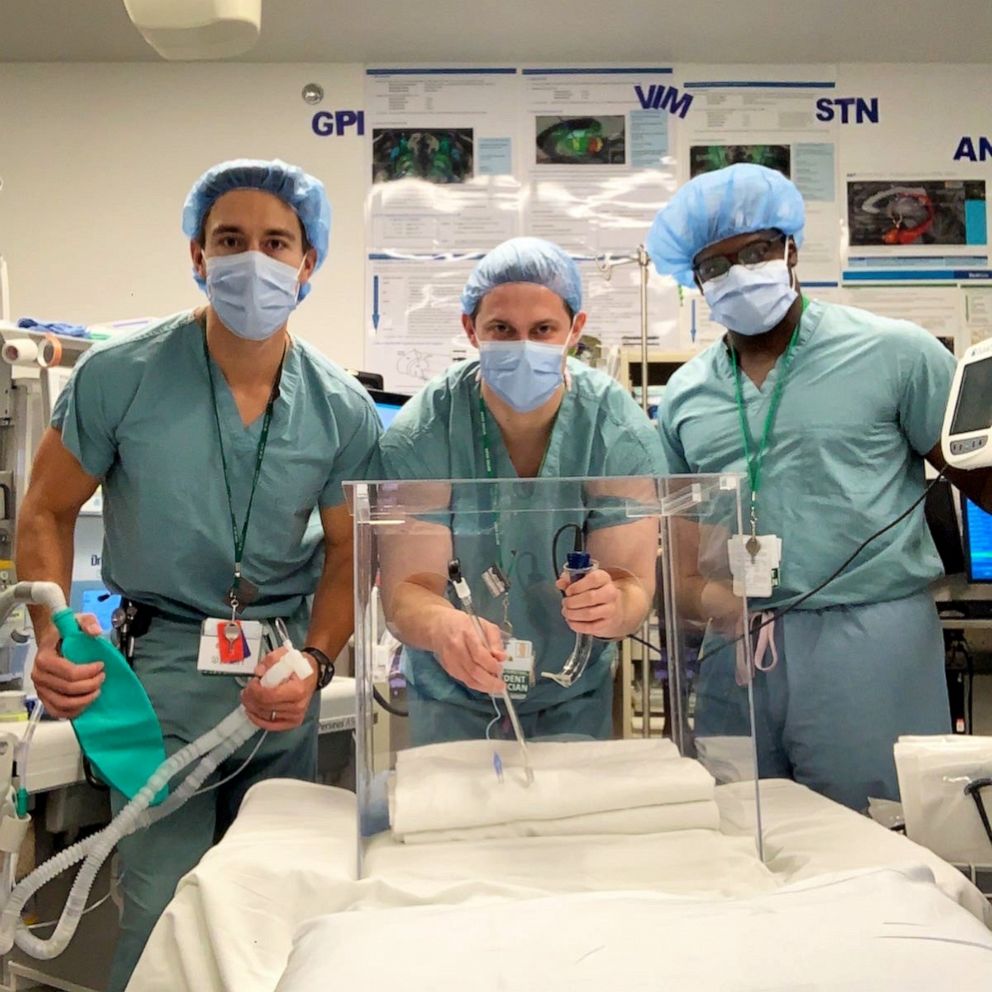Amid global pandemic, global on-the-fly innovation in some hospitals
American hospital uses Taiwanese design for "aerosol boxes."
With hospitals fighting over limited supplies of equipment to combat the coronavirus pandemic, some doctors and nurses working in the most sensitive settings are getting creative to protect themselves and their teams from the deadly disease, and finding help from an idea hatched half a world away.
ABC News previously reported on some hospitals using baby monitors to check in on their patients while limiting their exposure, and now some critical care workers said they are innovating again to solve a particularly tricky problem: how to intubate and extubate coronavirus patients -- meaning inserting a tube down a sedated patient's throat to give them oxygen and later removing it -- while still shielding themselves from exposure to the virus.
"During intubation and especially extubation, COVID-19 virus particles can become aerosolized and easily inhaled by the anesthesiologist, respiratory therapist, or nurse who are very close to the airway," Dr. Bryce Austell, the chief resident in anesthesiology at Rush University Medical Center in Chicago, told ABC News.
As hospital workers searched for a solution, one came to them over social media, shared from an ocean away in Taiwan: so-called "aerosol boxes."
The boxes are essentially clear, hollow, plastic or glass cubes about a foot and a half wide that have the bottom and one side open, two arm holes cut in another side. Placed over a patient's head as they're sedated and lying down, the boxes ideally allow healthcare workers to see and work with the intubation tube at the patient's mouth while only exposing their gloved hands and arms inside the cube.
Tune into ABC at 1 p.m. ET and ABC News Live at 4 p.m. ET every weekday for special coverage of the novel coronavirus with the full ABC News team, including the latest news, context and analysis.
"The aerosol box provides an extra barrier to the COVID-19 virus in addition to our standard PPE [personal protective equipment]," Austell said.
The boxes are not proven science and it's not clear how rigorously they have been tested. But a group of doctors who simulated an intubation using a box found that the “ad-hoc barrier [...] provided a modicum of additional protection and could be considered to be an adjunct to standard PPE,” according to a letter published in the New England Journal of Medicine.
The design, which has spread across the world on social media, spurned medical professionals and manufacturers into quickly replicating the overseas efforts in the U.S.
Some hospitals, like Rush, are constructing the devices in-house. Dr. Parag Patel said he came across a design for an aerosolized box from a Dr. HsienYung Lai in Taiwan, who reportedly posted his design online for doctors and manufacturers around the world to replicate. Patel enlisted Austell, who has a mechanical engineering background, and they set to work making prototypes with materials from Home Depot.
Patel and Austell also worked with engineers led by Hudson Vantrease at Wilson Sporting Goods to create a 3-D printed final product.

Austell said the boxes are now being used in the operating room, as well as the intensive care unit, and they have provided some to other local hospitals for use there as well.
Roy Kirchner, the founder and president of Ultimate 3D Printing Store in the Tampa, Florida area, had a similar idea and said he has quickly reoriented his businesses to produce the boxes using high-quality protective glass, after learning about the design of the Taiwanese doctor's innovation from a California doctor’s Facebook post.
“I just immediately saw him like, wow, this is something like I can immediately change from manufacturing lids for 3-D printers,” he told ABC News. “I started calling a couple of my fabricators and figured out we could make 50 to 60 a day.”
Kirchner is currently making and distributing the boxes to local Florida hospitals who have requested them, and is seeking to raise more money to purchase more high-quality plastic and distribute them across the country.
Larry Shore, the founder of Shore Plastics, a custom plastics manufacturer in the Baltimore area, has also started manufacturing the devices using Dr. Hsien Yung Lai’s design together with Maryland Thermoform Corporation, a plastics manufacturer that is also producing face shields along with the boxes, for hospitals from Baltimore to Calfornia.
Shore said he wanted to help protect frontline medical workers like anesthesiologists, who handle intubations and extubations at many hospitals.
"For them it's like standing next to a nuclear reactor. It's very scary," he told ABC News. "I'm getting calls from parents of doctors, where their sons or daughters are in the ER working, and they saw this online, and they want to get one and gift it to the hospital."
Given shortages of personal protective equipment, and the struggle some rural hospitals have in securing what they need in the midst of an outbreak concentrated in major cities, smaller facilities are becoming increasingly resourceful as well.
At the Adirondack Medical Center in upstate New York, which hasn’t been able to acquire aerosol boxes, respiratory therapists and doctors have practiced intubating patients under clear rain ponchos and drop cloths, which can be cheaply bought at local hardware stores and more readily accessible than the manufactured plastic boxes.
What to know about coronavirus:
- How it started and how to protect yourself: Coronavirus explained
- What to do if you have symptoms: Coronavirus symptoms
- Tracking the spread in the U.S. and worldwide: Coronavirus map
“Ultimately, we want proper airflow, ideally in a negative pressure room with proper PPE, but we also realized that might not be an option, as we get this influx of patients,” Rebecca Albright, a respiratory therapist at Adirondack Medical Center in Saranac Lake, New York, told ABC News.
And aerosol boxes are not a perfect solution. Doctors from two Boston hospitals, Boston Medical Center and Brigham and Woman’s Hospital, said in their letter published in the New England Journal of Medicine that the box “restricted hand movement” and required training before their use on patients, given some of the difficulties that can arise when patients are intubated and extubated.
"The aerosol box is not a replacement for proper PPE, but rather an added layer of protection to keep healthcare providers safe while they perform procedures that increase their risk of becoming infected by COVID," Patel said. "We are just trying to do our best to stay healthy for our patients and our families."
Albright said there's a "lot of controversy around whether it's effective or not."
But, she said, "At this point, when we’re dealing with a novel virus, most of it is novel ideas that come with it as far as the treatment path.”
Jay Bhatt, a practicing internist and Aspen Health Innovators Fellow, is an ABC News contributor.




